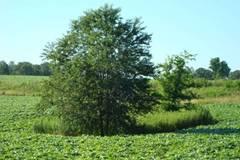
Establish grass filters in the areas adjacent to sinkholes to reduce the potential of sediments, chemicals, pesticides or organic matter entering the underground karst system.

Sensitive areas are areas of agricultural land where current management has impacted erosion, surface water and groundwater such as streams, sinkholes and springs. These practices are designed for the protection of water quality through: buffers collecting and filtering out sediment and other nutrients, herbicides and pesticides that could run off of crop fields; the exclusion of livestock, which prevents high nutrient and E. coli content while protecting the streambank from soil degradation at the same time; the protection of sinkholes and karst areas, which provide direct access to shallow groundwater, to protect drinking water aquifers and underground ecology.
The following state cost-share practices are designed to address this concern:
Details for each individual practice are available in the eligible practices chapter of the districts' Cost Share Handbook.

Establish grass filters in the areas adjacent to sinkholes to reduce the potential of sediments, chemicals, pesticides or organic matter entering the underground karst system.
Engineered practice that uses large stone or bioengineered techniques to protect streambank from eroding and provide a stable area to establish grasses or other vegetation to protect the soil and water resource from erosion losses and contamination.
Karst areas are particularly susceptible to groundwater contamination from many sources. This practice is aimed at reducing the potential of pollution from nonpoint sources to protect groundwater. It includes protected drains to allow infiltration of water into the subsurface.
Abandoned wells present a direct connection to the groundwater aquifer as well as a safety hazard. Wells that are properly treated, filled and sealed eliminate the safety hazard and protect the groundwater resource from possible pollution.
Reduce the impacts of wind erosion and improve irrigation efficiency in cropland by establishing trees and shrubs at the edges of crop fields minimizing the impact of wind.
Establish permanent grass buffers along the edges of crop fields to trap pesticide and fertilizer runoff. This practice reduces soil loss and improves water quality by preventing excess sediment and nutrients from entering streams.
Protect soil and shallow groundwater from contamination by sediments, chemicals, nutrients, pesticides or organic matter and protect stream banks from erosion by planting woody species along the stream course and protecting the buffer area from trampling and grazing.
Establish permanent grass filter strips below crop, hay and grazing land; and to prevent sediments, chemicals or nutrients from entering sensitive areas or water bodies.
Protect groundwater resources from contamination with collection points that provide dependable, safe water sources in a desired location for livestock watering.
Protect groundwater springs from pollutants by improving drainage of surface water and protecting those groundwater inlets by establishing buffer and exclusion areas to trap sediments, chemicals and organic matter.
Exclude livestock from stream corridors to allow revegetation with grasses and trees on the streambank. This also provides a filter to trap sediments, chemicals and nutrients.
